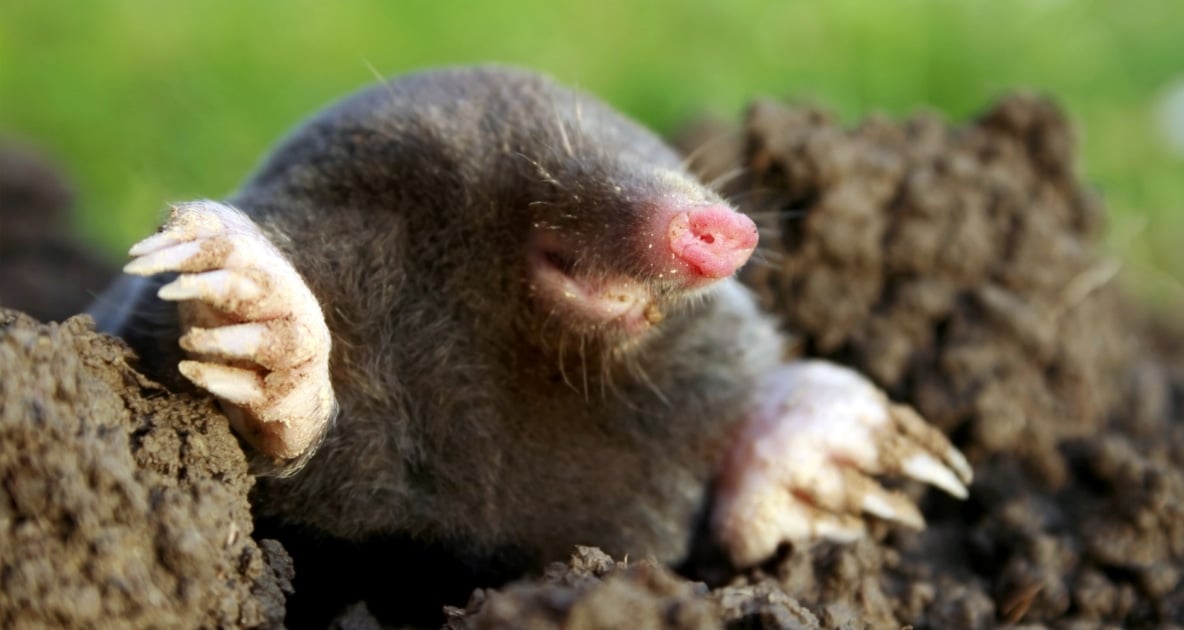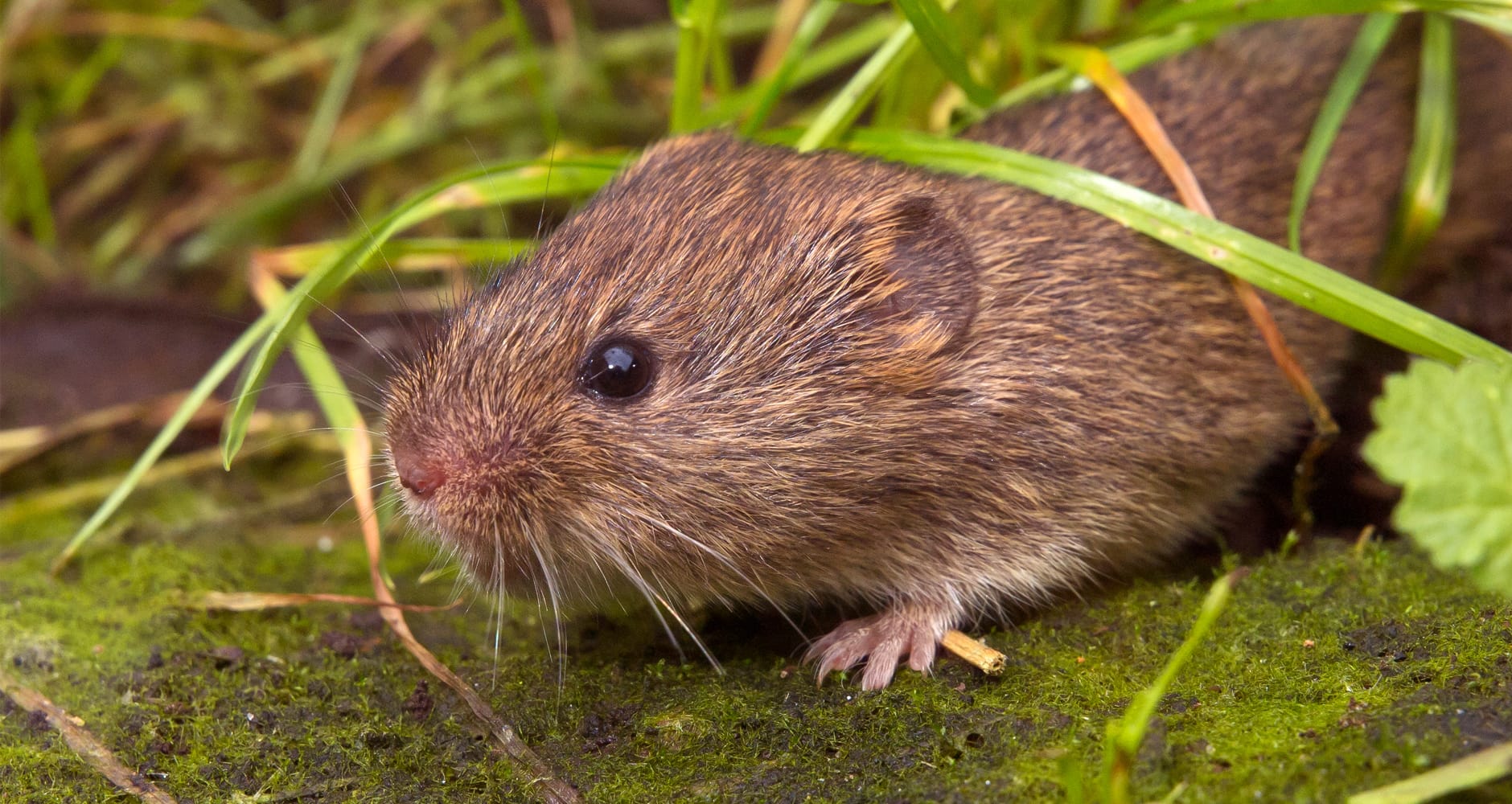Garden Pests: Moles and Voles
Practical strategies for keeping moles and voles from tearing up your lawn.

Wild animals are part of what makes nature so magical, and watching them can be highly enjoyable. While it’s important to coexist with animals in relative peace, they can cause countless problems when they take up residence in our homes or gardens. This month, moles and voles, Mother Nature’s pint-sized lawn wrecking crew.
Moles
Habitat and History
Moles can be found throughout North America, although primarily in the eastern and northwestern United States. There are seven species of moles, although the Star-Nosed and the Eastern are the most prevalent. Moles are gray or brown mammals and are actually NOT rodents. They are their own family of mammal. They have a long, naked snout, no external ears, large forelegs shaped like paddles and their eyes are hidden beneath fur.
Moles spend almost their entire lives underground, rarely coming to the surface. They prefer moist, loose soil. Moles are extremely territorial and will not allow other adults in their territory other than for mating.
Diet
The mole’s diet consists almost exclusively of earthworms and grubs. There is only one mole, which occurs in the far northwestern United States, that actually eats root crops and tubers. Think moles = meat.
Reproduction
Breeding for moles occurs in the late winter into early spring. There are generally four to seven young per litter, and they become active at about four weeks of age.
Problems, Solutions and Health Concerns
Moles do not pose any health-related concerns to humans. The thing that makes moles a pest is that they can devastate a lawn with mounds. These mounds can be either high and round or in the form of “running” tunnels.
There are several ways to rid your property of moles. You can purchase traps from your local hardware store, which can be placed right in the tunnels. You will need to remove the carcasses as they are trapped.
Another easy way to rid your property of moles is to use a lawn roller. Lawn rollers are steel wheels that are generally filled with water and pulled behind your riding mower. Once filled, they are very heavy and will crush the mounds and tunnels. This is a very effective way of eliminating moles. You will, however, have to do it as a regular maintenance routine.
Some people chemically treat their lawns for grubs. This eliminates the moles’ food supply, sending them on their way. Be warned, however, that there are health concerns associated with chemically treated lawns. Chemicals can leach into a well, garden plants, and even children, pets, or livestock that come into contact with it. If it’s green and can be mowed, it’s nice. Nobody needs “perfect grass.”
Voles
Habitat and History
Voles are found throughout North America. There are many different species of voles, but only about half a dozen of them cause significant problems for humans. Voles are a species of rodent, and are commonly mistaken for field mice or deer mice.
All voles are mouse-sized, measuring in at six to seven inches long and weighing approximately four to five ounces. Their eyes, ears, and tails are relatively small compared to mice. Some voles cause major surface damage, while others cause damage beneath the surface. Voles can be found in a large variety of habitats, and their ranges can overlap.
Diet
Voles are herbivores, feeding primarily on grasses, flowers, fruits, vegetables, bulbs, and roots. Some voles will also gnaw and feed on the bark of trees in winter, under the protection and cover of snow. Think voles = vegetables.
Reproduction
Like many other small rodents, voles are active breeders, with some species having four to five litters a year and two to five young per litter. In some warmer climates, they can breed year round. At around three weeks of birth, voles can begin breeding. Vole populations are cyclical, with a cycle of approximately three to six years.
Problems, Solutions and Health Concerns
All species of voles burrow, although most species are not subterranean. Some species of voles actually create runways by eating and munching vegetation in paths, almost like a trail system. They seem to stay in their nests most of the day, coming out to feed day and night at short intervals.
You can reduce the pressure from voles in a number of ways. First, you can keep your lawn mowed short. This will give the rodents less cover. You should also keep vegetation and brush away from flowerbeds, veggie gardens, and ornamental plants. Voles build their nests in these types of areas for cover.
Most damage from voles is to flowerbeds and gardens. The best way to keep your plants safe is to erect a barrier between your plants and the voles. Dig a trench around the area you want protected. The trench should be at least eighteen inches deep. This will also help deter other mammals such as woodchucks, ground squirrels, etc., too. Once the trench is complete, install 1/4” hardware cloth all the way to the bottom of the trench. Also note that the end of the hardware cloth at the bottom of the trench should be bent at a 90 degree angle, out about four inches. Now you can fill the trench back in. This helps to deter them from thinking they can dig around the hardware cloth.
Voles do not pose any infectious disease threat to humans.

Shawn Weeks
Shawn is a lifelong New Englander. He lives in Canton, Conn., with his wife Tami, mother, sister, and her three children. He and his wife have two grown children and two grandchildren. Shawn is an avid hunter, fisherman, and gardener. He is also a writer, a nuisance wildlife professional, small scale farmer, and scout leader. You can email him at [email protected].








What is the best dates to report house plants
I finally thought I had cured the vole problem with spending a couple hundred dollars on lawn services grub killer etc. a Stray cat showed up and is catching them and bringing me gifts so I let her spend a couple nights in the garage and this morning my lawn is torn up again I am at my wits end will the used kitty litter work in these holes to get rid of the voles or do I keep that cat out all night. I am needing an answer please
Living on just 2.5 acres, in the Historic District of a “once rural” NorCal town, our healthy plot is vast with wildlife & producing fruit trees, native plants, etc.. We cherish the critters which have share this property for as long as my family has owned this home (over 160 years). The endemic/indigenous & migratory wildlife have kept everything in a healthy balance………………
Of course, we ditched the lawn decades ago, in lieu of natural paths & flower beds. If you are into your lawn, this no doubt would not work for you.
Our zoo in Colorado Springs sells zoodoo for $2 lb. they gather big cats poop lion tigers mountain lions. It’s a fertilizer to put around edges of garden area.
Judy, interesting!
Do u mix the ammonia with water?
If you are in Hamilton county and parts of Mario county having issues with Moles or Voles drop me a line. I guarantee I will remove the issue!
I have just read about Nematodes. Combination is best -Heterorhabditis (stationary) and Feltiae (mobile). All natural. Kill all larvae – grubs,fleas,ticks,ants,cutworms, termites and ground wasps. Will not harm plants or animals.. Have to use every 3-4 weeks for infestation. Kill the food and moles leave. We also have tick/flea problems in south. Home depot has in some areas or they can ship to your store. Also check with gardening/landscape businesses.
You can also get those little wind spinners that kids likeand put in the ground. Stick them in the ground where you have them. The vibration from them scares them away. It really works
Greenwood 94661 Solar Mole Chaser. We buy this from Harbor Freight and leave it in one of our flower beds year round and we have not had a problem since.
We had mole damage in our lawn every spring when the snow melted. We read that sprinkling coffee grounds over the lawn would repel the moles. Now we do this every fall and there is no more mole damage, but we must do it every fall. (We also heard that sprinkling human hair clippings on the lawn would also repel moles, but we haven’t tried that.)